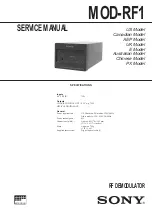
Electro-Optic Phase Modulator
Page 5
15952-D02 Rev.B, 1/26/2012
Chapter 2 Setup
WARNING
Do not remove cover. High voltages are used to drive the crystals. Contact
with these high voltages may be harmful to the user.
2.1. Unpacking
The modulator is shipped form the factory ready to be placed into your setup.
Carefully unpack the modulator and inspect the optics by looking through the
aperture. If the modulator is shipped with protective tape over the optical
apertures, it will need to be removed prior to operation.
2.2. Generating RF Sidebands
An EO phase modulator is ideal for generating RF sidebands on top of a laser
line. By applying a sinusoidal varying RD drive voltage, the phase of the optical
signal will have a time varying sinusoidal modulation at the same frequency as
the modulating signal. This phase modulation will result in a frequency
modulation of the optical signal.
If the frequency modulated signal is viewed with a spectrum analyzer (i.e., with
Thorlabs Scanning Fabry-Perot Interferometer), a series of sidebands can be
easily observed. These sidebands are an infinite series with each pair of
sidebands spaced symmetrically about the fundamental with a separation equal
to a multiple of the modulation frequency (i.e. with a laser operating at a
fundamental of f
o
, and a modulation frequency of f
m
, the first pair of side bands
will be at f
o
± f
m
, the second pair of sidebands will be at f
o
± 2*f
m
, etc.).
The amount of energy transferred from the fundamental to the n
th
sideband with
a phase modulation depth of
radians is described by the square of the Bessel
function of order n, J
n
(
)
2
. Figure 2 on page 6 shows the relative power of the
fundamental and the first three sidebands as a function of the phase modulation
depth.


























